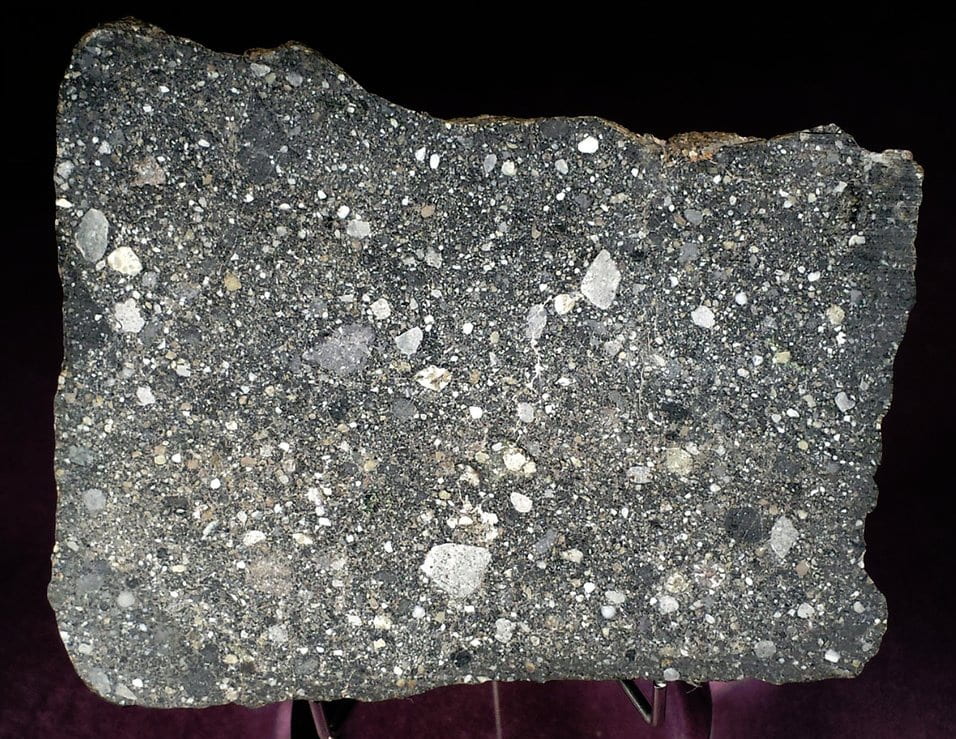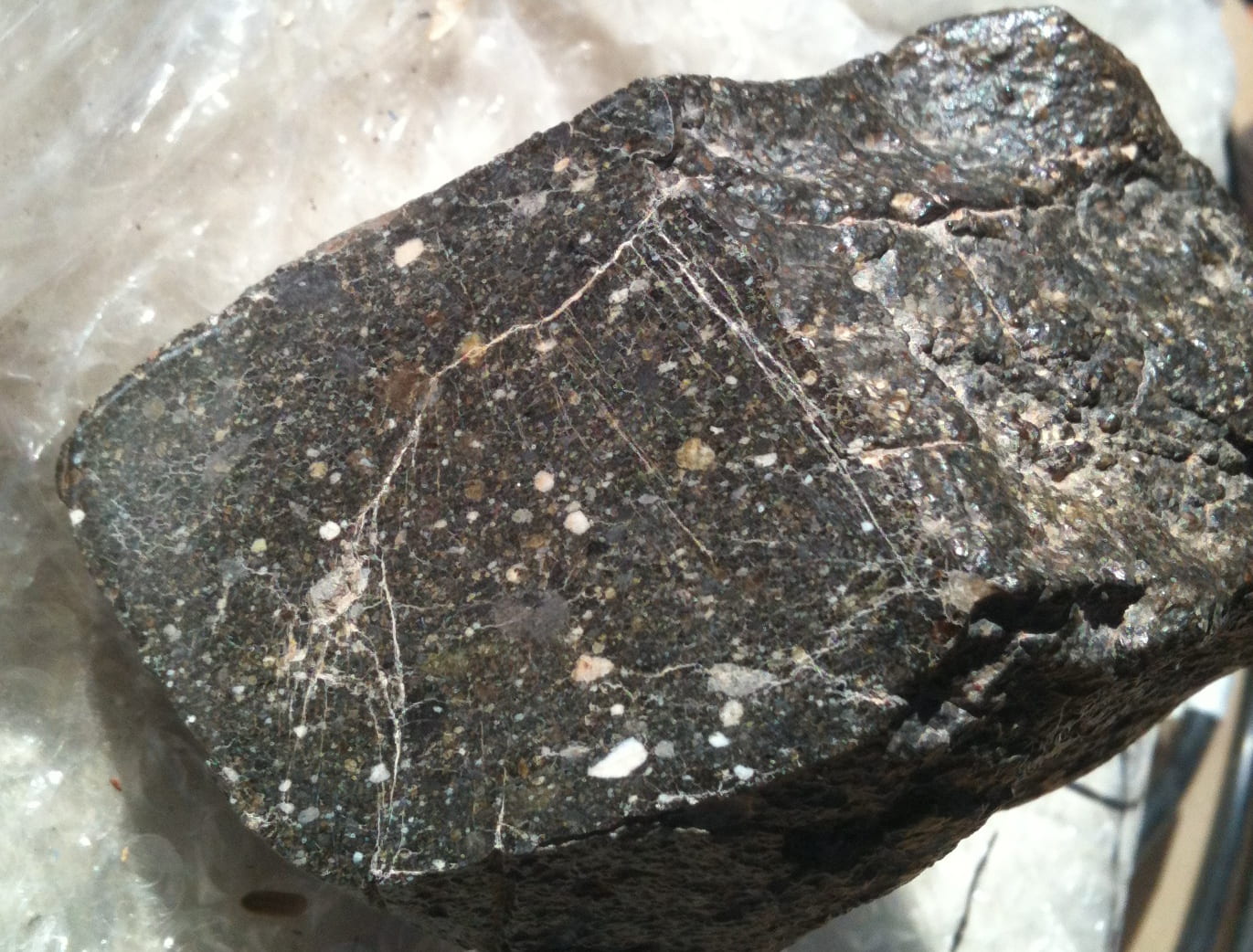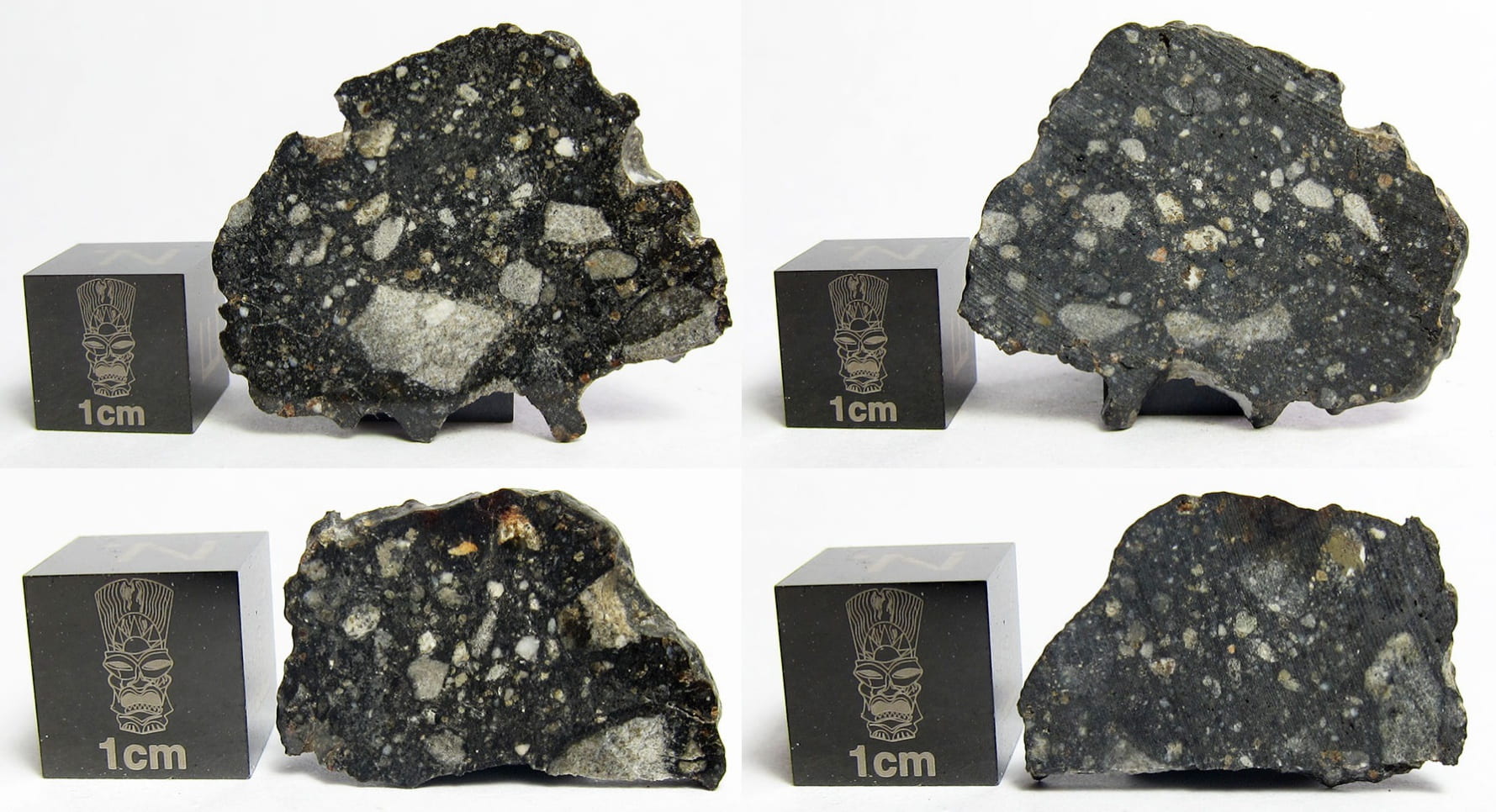Lunar Meteorite: Northwest Africa 7611 clan
The NWA 7611 clan consists of paired stones NWA 2402, 7611, 8277, 10480, 10566, and an unnamed pair








|
from The Meteoritical Bulletin, No. 108 Northwest Africa 2402 (NWA 2402)(Northwest Africa) Lunar meteorite History: The meteorite was exported from Morocco to Tucson where it was purchased by N. Gessler. Physical characteristics: Weathered reddish-black fusion crust on one side. Dark-gray matrix with abundant clasts, frequently angular in outline, up to 8 mm, varying from white to near-black. Petrography: (P. Warren, UCLA) The texture is an immature regolith breccia, gradational with polymict nonregolithic (fragmental) breccia. A finite but very sparse abundance of regolithic spheroids (two identified in a large thin section) is the main indication for an immature regolith breccia. The groundmass is mafic-rich. Clasts vary in mode from Ti-poor basaltic to anorthositic (9/10 plagioclase, granulitic). Pyroxene is the dominant mafic silicate; and in the groundmass, in the basaltic clasts, and in relatively coarse mineral clasts, mostly shows a similar fine, roughly µm-scale, exsolution. Lithic clast textures include vitrophyric, fine-scale poikilitic (impact melt?), granulitic, and medium-grained basaltic. One unusual clast, 0.4 × 0.2 mm, consists of a symplectitic intergrowth of roughly 50% ferroan olivine, 35% silica and 15% augite (with very fine-scale exsolution lamellae of low-Ca pyroxene) and 0.5% ilmenite. Geochemistry: On the pyroxene quadrilateral, compositions (28 analyses) scatter evenly across the space bounded by Fs22Wo9, Fs54Wo6, Fs52Wo21 and Fs38Wo39; the last being the pyroxene of the olivine-silica-pyroxene simplectitic clast. Pyroxene FeO/MnO averages 65.5. The olivine of the sympectitic clast is uniformly Fa83. Olivine elsewhere is as magnesian as Fa28. Plagioclase (8 analyses) ranges from An88 to An97, the latter extreme coming from the same poikilitic highland clast that yielded the Fa28 olivine. Two glassy spheroids have VLT-mare compositions similar to glasses in Yamato 793274. The bulk composition, determined by INAA and fused-bead EPMA applied to 2 chips totaling 760 mg, has 18 wt% Al2O3, 12.2 wt% FeO and Mg/(Mg+Fe) = 57 mol%, a combination that (along with the spheroids, and the compositional spread and slight exsolution in much of the pyroxene) suggests a significant VLT-mare component. The bulk TiO2 is only 0.58 wt%. The bulk-rock concentration of the arch incompatible element Th is 1.0 µg/g. Geochemically as well as petrographically, this sample strongly resembles the first highland-mare mixed breccia, Yamato 793274. Classification: Lunar mixed highland-mare breccia. Specimens: Main mass with Gessler, type specimen at UCLA. |
|
from The Meteoritical Bulletin, No. 101 Northwest Africa 7611 (NWA 7611)Morocco Lunar meteorite History: Reportedly found near the Moroccan/Algerian border in May 2012. Purchased from a Moroccan meteorite dealer in 2012. Physical characteristics: Single 916 g stone, no fusion crust, smooth exterior with numerous light- and dark-colored clasts, saw cuts reveal brecciated texture with white feldspar and green-brown pyroxene and olivine grains (up to 3 mm) set in a darker gray-green matrix; scattered gabbroic and dark clasts up to 1 cm. Petrography: (C. Agee, UNM; A. Irving, UWS) Microprobe examination of a polished 7 × 2 cm sawn slice and a separate polished mount shows a fragmental breccia of plagioclase, pyroxene, and olivine grains in a wide range of grain sizes. A prominent ~1-cm pyroxene-plagioclase gabbroic clast was observed as well as several smaller gabbroic fragments. One small clast consists of intergrown hedenbergite+fayalite+silica (after pyroxferroite). The groundmass is variable with some domains showing a uniform fine-grained subophitic plagioclase-pyroxene texture, while other domains show densely packed mineral clasts ranging from 10-300 µm. There are several sharp boundaries between the various textural domains, with at least two compositionally distinct olivine populations, and a wide range of pyroxene compositions, indicating multiple lithologies of a mingled fragmental breccia. Accessory ilmenite, silica polymorph, minor zircon, troilite, Ti-bearing chromite, Ni-free iron metal and kamacite are present. Geochemistry: (C. Agee and M. Spilde, UNM; A. Irving and S. Kuehner, UWS). Fayalitic olivine Fa90.6±5.7, Fe/Mn=90±4, n=15; forsteritic olivine Fa31.6±11.1, Fe/Mn=93±9, n=3; pyroxene Fs43.6±13.3Wo20.2±8.5, Fe/Mn=67±8, n=37; pyroxene in gabbroic clast Fs45.3±13.1 Wo15.4±5.3, Fe/Mn=69±7, n=12; plagioclase An93.5±1.5Ab6.0±1.4Or0.5±0.5, n=13. Bulk composition: (R. Korotev, WUSL). INAA on 4 subsamples gave the following mean values: Na2O=0.405, CaO=14.8, FeO=11.27 (wt%); Sc=25.1, Cr=1692, Co=37.6, Ni=181, La=6.38, Nd=8.9, Sm=3.07, Eu=0.891, Lu=0.321, Hf=2.12, Ir=0.0044, Au=0.0036, Th=0.97, U=0.36 (ppm). Oxygen Isotopes, laser fluorination (K. Ziegler, UNM), 6 analyses on 3 acid-washed aliquots gave mean values d17O=3.161±0.080, d18O=5.931±0.031, Δ17O=0.030±0.075 (linearized, all permil). Classification: Achondrite (lunar, mingled breccia), high bulk FeO and Sc, and fayalitic olivines suggest the presence of a mare basalt component. Specimens: A total of 20 g is on deposit at UNM. The remainder is divided between Jay Piatek, Matt Morgan, Mike Hankey, and Haag; Jay Piatek holds the main mass. |
|
from The Meteoritical Bulletin, No. 103 Northwest Africa 8277 (NWA 8277)(Northwest Africa) Classification: Lunar meteorite (feldspathic breccia) History: Purchased by Adam Aaronson in Morocco, 2013. Physical characteristics: Single stone, no fusion crust, irregular sandblasted exterior with numerous light- and dark-colored clasts. Saw cut reveals brecciated texture with white feldspar and green-brown pyroxene and olivine grains (up to 3 mm) set in a dark gray-green matrix. Petrography: (C. Agee, UNM) Microprobe examination of polished mount shows a fragmental breccia of plagioclase, pyroxene, and olivine grains in a wide range of grain sizes. The groundmass is variable with some domains showing a uniform fine-grained subophitic plagioclase-pyroxene texture, while other domains show densely packed mineral clasts ranging from 10-300 µm. There are several sharp boundaries between the various textural domains, with at least two compositionally distinct olivine populations, and a wide range of pyroxene compositions, indicating multiple lithologies of a mingled fragmental breccia. Accessory ilmenite, silica polymorph, and troilite. Geochemistry: (C. Agee, UNM). Fayalitic olivine grain Fa92.0, Fe/Mn=92; forsteritic olivine Fa41.1±11.8, Fe/Mn=103±8, n=9; pyroxene Fs40.5±12.9Wo22.4±9.4, Fe/Mn=65±9, n=63; plagioclase An90.9±7.2Ab8.6±6.8Or0.5±0.5, n=30. Classification: Achondrite (lunar breccia), comparison of macroscopic and backscatter-electron textures, geochemistry of pyroxenes, olivines, and plagioclase, indicate that this meteorite is likely paired with NWA 7611. Specimens: A total of 21 g including a probe mount on deposit at UNM. Aaronson holds the main mass. |
|
from The Meteoritical Bulletin, No. 104 Northwest Africa 10480 (NWA 10480)(Northwest Africa) Classification: Lunar meteorite History: The meteorite was purchased from the Moroccan meteorite dealer Ismaili at the mineral fair in Munich, Germany. Physical characteristics: One small individual covered with a black shiny crust was recovered from the north-African Sahara. Petrography: (A. Greshake, MNB) The meteorite is a polymict breccia composed of lithic and mineral clasts set in a fine-grained clastic matrix. Lithic clasts are dominantly gabbroic, basaltic and impact melt up to 5 mm in size; mineral clasts include olivine, fayalite, pyroxene with very fine exsolution lamellae, and feldspar grains. Accessories are pigeonite (Fs55.3Wo13.7), Ti-chromite, ilmenite, and silica. Some melt veins and pockets are present. Geochemistry: olivine: Fa34.1±2.2 (Fa31.7-40.3, n=24) FeO/MnO mean= 100±9; fayalite: Fa92.3±3.9 (Fa83.7-97, n=26) FeO/MnO mean= 97±5; Ca-pyroxene: Fs39.1±9.5Wo32.4±9.6 (Fs29.7-55.8Wo20.3-43.3, n=33, FeO/MnO mean= 79±11.9); calcic plagioclase: An93.4±1.6 (An90.2-94.6, n=16). |
|
from The Meteoritical Bulletin, No. 104 Northwest Africa 10566 (NWA 10566)(Northwest Africa) Classification: Lunar meteorite (feldspathic breccia) History: Purchased by Dr. David Gregory in January 2015 from a Moroccan dealer at the Tucson Gem and Mineral Show. Petrography: (A. Irving and S. Kuehner, UWS) Fragmental breccia composed of angular mineral clasts of anorthite, pigeonite, ferropigeonite, orthopyroxene, augite, fayalitic olivine, silica polymorph, ilmenite, Cr-Ti-Fe spinel, troilite and kamacite, plus sparse rounded to angular glass fragments, set in a finer matrix. Some pigeonite grains are exsolved. Geochemistry: Low-Ca pyroxene (Fs29.8Wo5.2, FeO/MnO = 50), pigeonite (Fs23.7Wo10.0, FeO/MnO = 44), ferropigeonite (Fs55.2Wo16.2, FeO/MnO = 66), augite (Fs44.5Wo38.9, FeO/MnO = 66), fayalite (Fa71.2; Fa96.2; FeO/MnO = 82-108; N = 2), plagioclase (An94.6-97.0Or0.2-0.0, N = 2). Bulk composition: (R. Korotev, WUSL): INAA of subsamples gave (in wt.%) Na2O 0.41, FeO 13.86; (in ppm) Sc 30.2, Cr 1920, Co 42.3, Ni 190, La 6.76, Sm 3.20, Eu 0.888, Yb 2.30, Lu 0.324, Hf 2.2, Th 0.93. Classification: Lunar (feldspathic breccia). Paired with NWA 7611 and NWA 8277 based on matching bulk elemental compositions. Specimens: 20 g including one polished thin section at ROM; remainder with Gregory. |
| Randy Says… I call this the NWA 7611 clan because NWA 7611 was the first stone of the clan to have been classified. I assume that NWA 2402 is a member of the pair group from Paul Warren’s description above. Northwest Africa 7611 (symbol 7 in the figure below), NWA 8277 (8), 10480 (0) and 10566 (5) are regolith breccias that are almost certainly paired with each other and that each consist of a mixture of feldspathic and basaltic rock pieces. Compositionally, they are indistinguishable from NWA 4884 (4) and together the four stones are different from any other NWA lunar meteorites except NWA 2402. A colleague who has seen both NWA 4884 and NWA 7611 in hand says that they look different, however. The one compositional difference is that NWA 7611, NWA 8277, and NWA 10566 are all more contaminated with terrestrial barium (Ba) than is NWA 4884 and this is a good argument that they were not found in the same location. So, that leaves the coincidence that NWA 4884 and the NWA 7611 clan are likely launch pairs that both landed in the Sahara. But, maybe it is not as much of a coincidence as it first seems. These four NWA stones are also compositionally indistinguishable to QUE 94281 (Q), Yamato 793274/981031 (Y), and DEW 12007 (D), all from three different places in Antarctica. They may also be launch paired, along with EET 87521/96008 (Antarctica; Korotev et al. 2003; Korotev and Zeigler, 2014) Although some of these meteorites are described above as “feldspathic,” on average they are subequal mixtures feldspathic material and mare basalt.  In the figure, numeric points each represent a small (25-35 mg) subsample of the five NWA stones that I have analyzed. For “well-behaved” elements like iron and sodium (left) the points lie along a trend between the feldspathic and basaltic components of the meteorites. NWA 8277 (8) has higher FeO on average than does NWA 7611 (7) because my small sample of NWA 8277 is a bit richer mare basalt than are my samples of the other two stones. NWA 4884 (4) lies in-between. Barium concentrations (right) in NWA 4884 are the same as for the Antarctic meteorites (D, Q, and Y). NWA 7611, 8277, and 10291 are contaminated with Ba from terrestrial alteration in the hot, but sometimes wet, desert. |
More InformationMeteoritical Bulletin Database NWA 2402 | 7611 | 8277 | 10480 | 10566 References Agee C. B., Korotev R. L., and Irving A. J. (2013) Petrology and bulk composition of two lunar fragmental breccias: Northwest Africa 7493 and Northwest Africa 7611. 44th Lunar and Planetary Science Conference, abstract no. 2629. Cao H., Chen J., Yin C., Fu X., Ling Z., and Che X. (2024) The lithologic diversity of the Moon recorded in lunar meteorites Northwest Africa 7611 and 10480. Meteoritics & Planetary Science. https://doi.org/10.1111/maps.14131 Korotev R. L. (2013) Siderophile elements in brecciated lunar meteorites. 44th Lunar and Planetary Science Conference, abstract no. 1028. Korotev R. L. and Irving A. J. (2013) Keeping up with the lunar meteorites – 2013. 44th Lunar and Planetary Science Conference, abstract no. 1216. Korotev R. L. and Irving A. J. (2015) Keeping up with the lunar meteorites – 2015. 46th Lunar and Planetary Science Conference, abstract no. 1942. Korotev R. L. and Irving A. J. (2016) Not quite keeping up with the lunar meteorites – 2016. 47th Lunar and Planetary Science Conference, abstract no. 1358. Korotev R. L. and Irving A. J. (2017) Still not keeping up with the lunar meteorites – 2017. Lunar and Planetary Science XLVIII, abstract no. 1498. Korotev R. L. and Irving A. J. (2021) Lunar meteorites from northern Africa. Meteoritics & Planetary Science, 206–240. Korotev R. L. and Zeigler R. A. (2014) Chapter 6. ANSMET Meteorites from the Moon, Thirty-five Seasons of U.S. Antarctic Meteorites (1976–2010): A Pictorial Guide to the Collection (editors K. Righter, R. P. Harvey, C. M. Corrigan, and T. J. McCoy), 101–130, Special Publications 68, American Geophysical Union, Washington, D. C., 296 pages, ISBN: 978-1-118-79832-4. Korotev R. L., Jolliff B. L., Zeigler R. A., and Haskin L. A. (2003) Compositional constraints on the launch pairing of three brecciated lunar meteorites of basaltic composition. Antarctic Meteorite Research 16, 152-175. Korotev R. L., Zeigler R. A., and Jolliff B. L. (2004) Compositional constraints on the launch pairing of LAP 02205 and PCA 02007 with other lunar meteorites. Lunar and Planetary Science XXXV, abstract no. 1416. Liu Y., Ling Z., Wu P., Wang J., Cao H., and Chen J. (2021) Mineralogy of lunar meteorite Northwest Africa 10480 by Raman spectroscopic studies. 52nd Lunar and Planetary Science Conference, abstract no. 2003. Nishiizumi K., Caffee M. W., and Jull A. J. T. (2016) Exposure history of Mount DeWitt 12007 and proposed launch-paired Northwest Africa 4884, 7611, and 8277 lunar meteorites. 79th Annual Meeting of the Meteoritical Society, abstract no. 6514. |